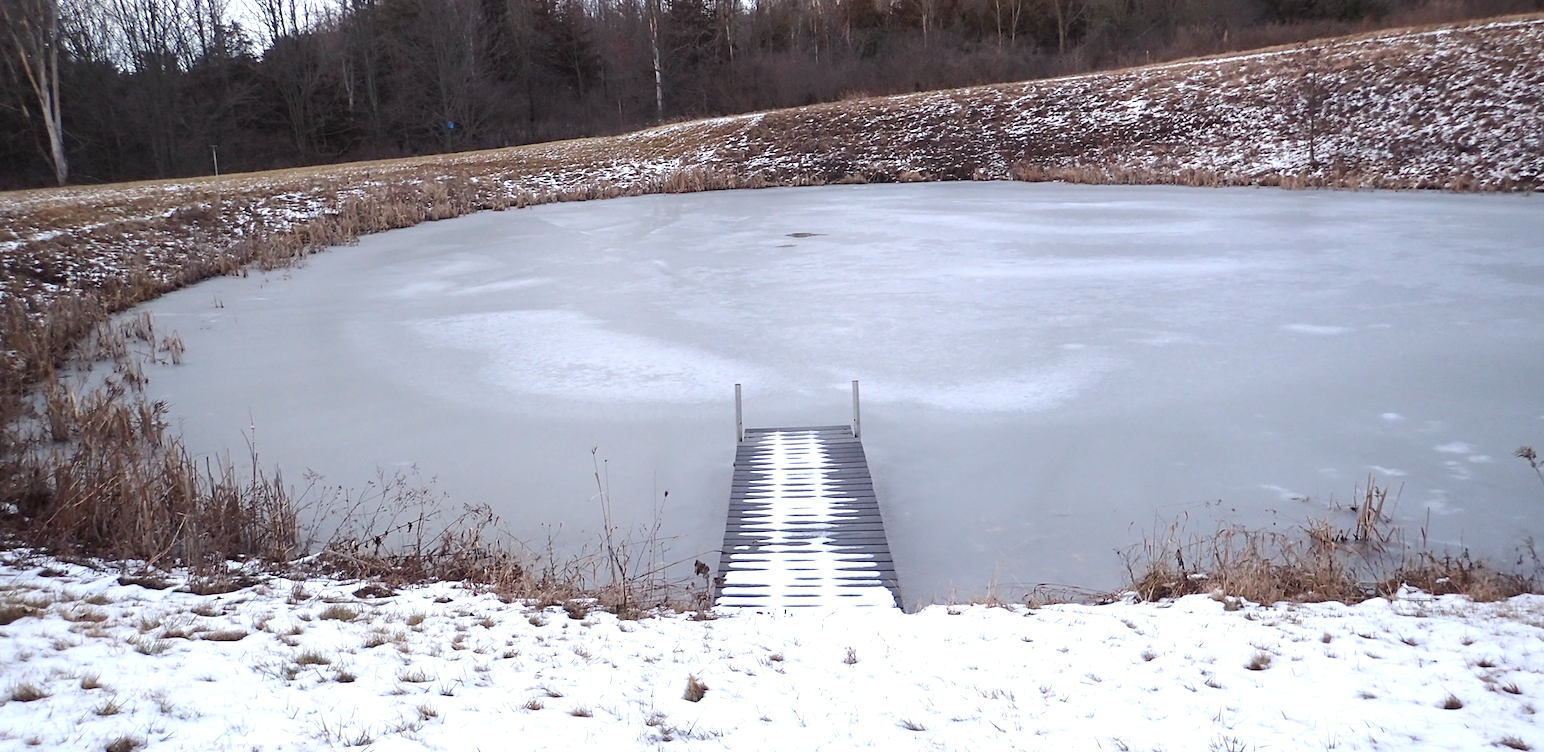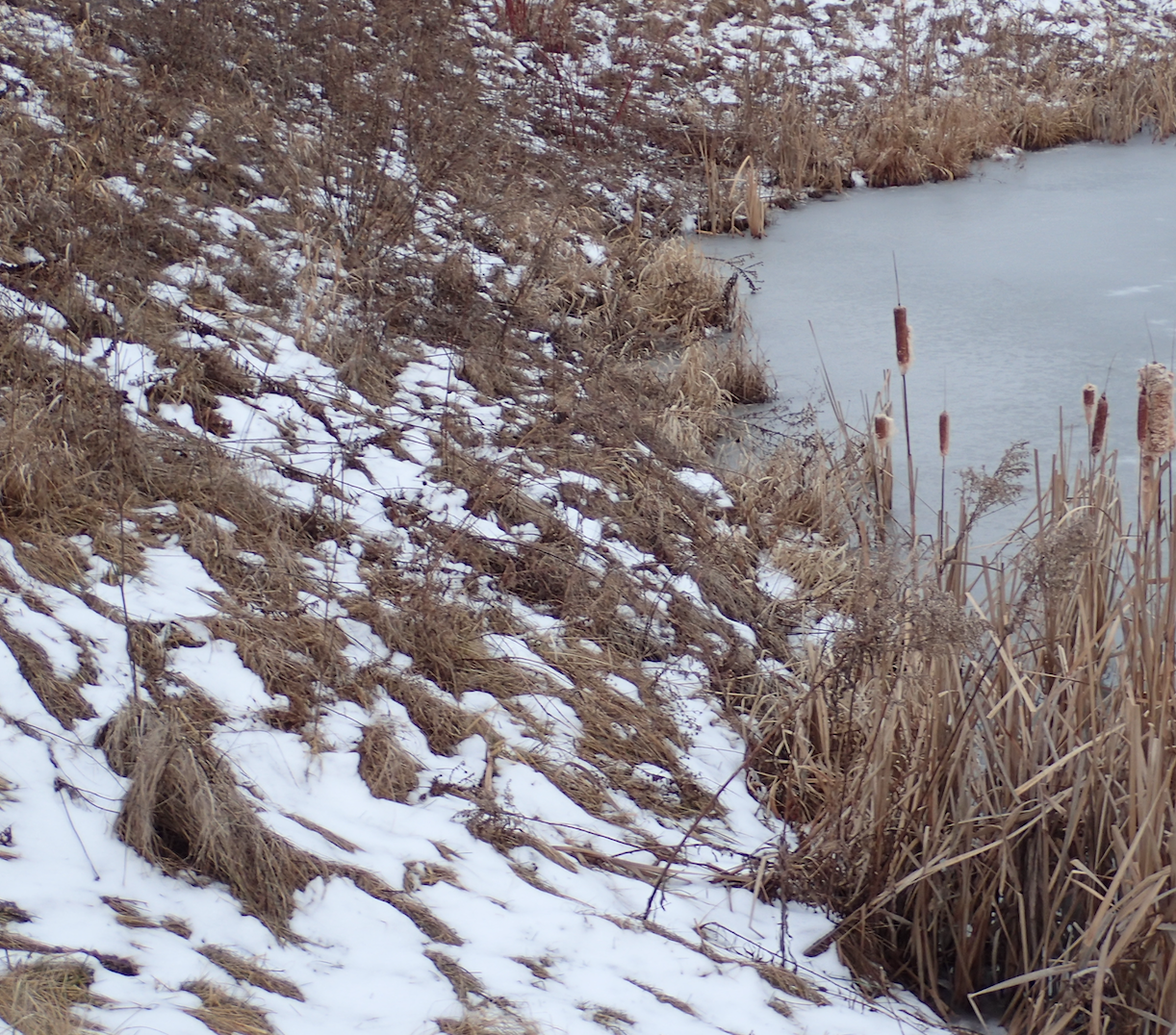
Small Ponds
Small or shallow ponds present some hazards that are often unexpected. Their size and shallowness allow the water in them to cool quickly and catch easily. They often provide early season ice. They also come in early enough in the season that they are likely to see significant warm spells with the attendant risks of ice weakened and thinned by thawing. During a thaw in ice less than three inches thick, grain boundary melting can take place in a couple hours in warm conditions, especially in the spring when the sun is strong and the days are long. If the ice was weak yesterday from thaw conditions but feels hard and strong in the morning it may be an illusion. The only hard ice is on the surface. It is called overnight ice. The sun only has to soften the hard top layer to make the ice sheet much weaker.
Snow and pond ice:
When pond ice becomes snow covered it is common to shovel off a portion for skating. Ice under the snow piles or under the unshoveled snow is insulated and does not thicken as fast as exposed ice. In shallower ponds or ponds with significant ground water inflow, the ice under the snow may get thinner in moderately cold conditions. It is a good idea to keep track of what is going on with ice thickness under the snow as well as where the ice is shoveled off.
Any place the snow cover is over about 50% of the ice thickness, its weight typically will press the ice surface below the natural water surface (negative freeboard) and water will find its way through cracks and holes in the ice and capillary action wicks it into the bottom couple inches of the snow cover. This wicking adds more weight and pushes the ice deeper. On any ice surface, heavy snows can result in a thick slush layer, often, but not always, covered by dry snow. If the underlying black ice is relatively thin for the activities on the ice this can create a deceptive situation where the ice sheet strength is highly variable but looks relatively uniform. Lake Dunmore in 2010 and Waterbury Reservoir 2012 are examples.
Swampy Areas: Cattail and other vegetation combined with their shallow water often lead to thin ice in and, sometimes, near swampy shoreline.
 The two test poles easily poked through the ice (less than 2" thick). The ice a couple feet further out was about 4". There were several areas around the edge of the pond that were thin. The ice has been through a 30 thaw-degree day thaw (January).
The two test poles easily poked through the ice (less than 2" thick). The ice a couple feet further out was about 4". There were several areas around the edge of the pond that were thin. The ice has been through a 30 thaw-degree day thaw (January).
Under ice melting of pond ice:
Most bodies of water are too deep for the small amount of heat that is conducted from the bottom sediments to have a significant effect on the bulk water temperature. Relatively warm ground water has difficulty penetrating a thick winter stagnation layer generally found in deeper water bodies. Likewise, solar heating of water through the ice in early to mid-winter is easily dissipated in a thick 'winter stagnation' layer-water heated near the surface is more dense so it sinks away from the bottom of the ice sheet. Shallow ponds are another story. With a much thinner stagnation layer, these effects can result in warming of the water near the bottom of the ice sheet which will inhibit growth or cause thinning the ice sheet.
Thawing of ice sheets on ponds:
Shallower ponds often go out significantly earlier than deeper water bodies even though the deeper water never developed the same maximum ice thickness the shallower pond had. In shallow ponds it is common for the black ice layer on the bottom of the ice sheet to melt first so that by later winter only snow ice is left. This is the reverse of what typically happens on ice sheets over deeper water. Snow ice in the process of thawing gets quite weak. From the top you can only see the white, snow ice layer which looks the same as it did a couple weeks ago when it still had a strong black layer. A friend who has a 75 foot diameter pond about 10 feet deep was considering skating on it one last time in early March until he figured out that the residual snow ice was about two inches thick and had no black ice underneath it.
Some suggestions:
- Approach ponds with the same precautions you would with any ice: Test pole, ice claws, throw rope, a buddy, a life jacket and due caution. Even though they are small and do not have some of the hazards associated with larger bodies of water they often have problems of their own.
- Check the ice carefully every time you go out on it.
- If you remove snow, try to pile it off the pond. If you do pile it on the ice, check out the ice near and under the piles regularly and generally stay away from those areas otherwise. It is better not to put all the snow in one big pile.
- If you are using equipment like a snow blower, remember to take it's weight into consideration, especially near an existing snow cover, swampy areas, inlets and outlets.
- If you are thinking of using a vehicle driven plow or snow blower, be warned that this is a high risk endeavor. Make doubly sure you will have plenty of uniform, hard, cold ice everywhere you plan to plow. Vehicles with plows on them sink especially fast....dump trucks in about three seconds! Cabs or weather protection covers can delay getting away from the vehicle if breaks through.
- Have a roped, rescue throw ring on a post by the pond, just in case
- Expect the ice to go out early and from the bottom up.
- Ground water in the form of springs and streams is more likely to be a problem on a shallow pond. It is possible that a true 'spring fed' pond will get much of the heat to melt the ice from ground water flowing into the pond.
- Don't let their small size or shallowness fool you. If you break through ice in water up to your chest and you can't get out, you are in almost as much trouble as you would be in deeper water. Their typical mud bottoms have their own set of problems.
- Read the 'Key Points' page for a quick review of ice safety. The rest of the site has lots of additional information.
Bob
PS: if you have a pond ice story, please send it along.
 A steep bank at the side of a pond may also have a steep slope under the ice. If the ice is thin, someone who slips or slides down the slope might have enough momentum to get pushed under the ice sheet.
A steep bank at the side of a pond may also have a steep slope under the ice. If the ice is thin, someone who slips or slides down the slope might have enough momentum to get pushed under the ice sheet.
